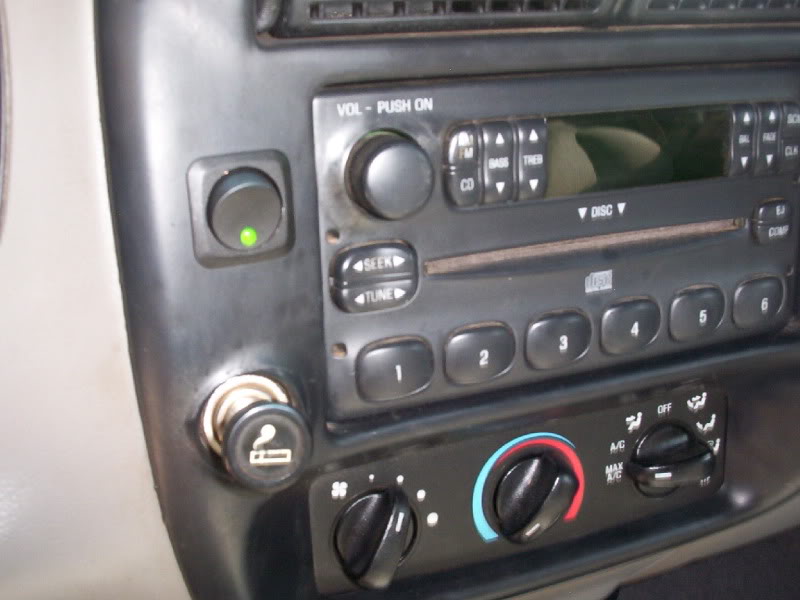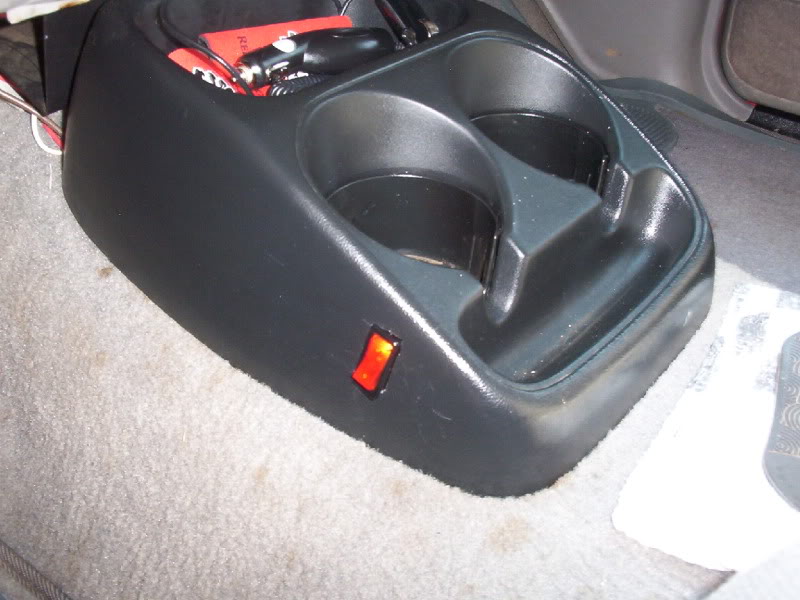help with KCs
#26
after listning to what everyone has had to say......... its finally done! and done right. i had the lights on a while and theres no heat off any wires. a relay and now 2 fuses with 10 ga seems to be fine. i only ran to 10 to the relay. and the fuse block came with about 12 ga so i put the between the relay and the battery. thank you you to everyone who gave me advice. i would have never attempted this with out being able to talk to you guys.
oh and heres the switch i used and mounted

and heres the old one for the fogs and lights behind the grill.

oh and heres the switch i used and mounted

and heres the old one for the fogs and lights behind the grill.

#27
Tim --
If you've got one "main" wire going from the battery to all three relays, then the entire current draw of all five 100W lights is going through that first wire!
5 x 100W = 500W
Watts = Volts x Amps
500 = 13.8 x Amps
500/13.8 = Amps
36.23A of current
You have placed a 50A fuse on that wire, which means it will allow up to 50A of current to pass before the fuse blows. A 14 ga wire should not have that kind of current running through it! If it were my truck, I would definitely be rewiring that circuit!
------------------------------------------------------------------------------------
Shane / All --
Typically speaking, when you're specifying parts, safe engineering practice is to allow for twice the expected maximum in components and wiring, and only slightly above the expected maximum when specifying protection components (fuses and circuit breakers). If you're expecting to routinely see 25 ~ 30A of current on a particular wire, then the wire should be capable of carrying 50 ~ 60A, and the fuse on that wire should be no larger than 30A.
When you specify components closer than that, you run into significantly more physics -- as you reach the maximum current carrying capacity of a given wire, that wire will tend to radiate some of the energy as heat. That heat will then change the conductive characteristics of the wire, effectively adding a resistive load to the circuit. This, in turn, will increase the current flow through the circuit, which then increases the heat produced, which in turn increases the resistance, which in turn increases the current... and so on, and so on, until failure (and fire).
That said, I'll tell you how I've always wired aux lighting automotive circuits. You may take from it what you will... perhaps I'm being overly cautious, but I've never had an electrical fire in any of the vehicles I've wired:
(+) ---[30A fuse]-----------------[Relay Common] <-- 10 ga. wire
[Relay N.O.]----[30A fuse]--------[aux light + ] <-- 10 ga. wire
(+)---[2A fuse]----------------[switch common] <-- 16 ga. wire
[switch N.O.]--[2A fuse]-------[Relay coil + ] <-- 16 ga. wire
[Relay coil - ]-------------------[GROUND] <-- 16 ga. wire
If you've got one "main" wire going from the battery to all three relays, then the entire current draw of all five 100W lights is going through that first wire!
5 x 100W = 500W
Watts = Volts x Amps
500 = 13.8 x Amps
500/13.8 = Amps
36.23A of current
You have placed a 50A fuse on that wire, which means it will allow up to 50A of current to pass before the fuse blows. A 14 ga wire should not have that kind of current running through it! If it were my truck, I would definitely be rewiring that circuit!
------------------------------------------------------------------------------------
Shane / All --
Typically speaking, when you're specifying parts, safe engineering practice is to allow for twice the expected maximum in components and wiring, and only slightly above the expected maximum when specifying protection components (fuses and circuit breakers). If you're expecting to routinely see 25 ~ 30A of current on a particular wire, then the wire should be capable of carrying 50 ~ 60A, and the fuse on that wire should be no larger than 30A.
When you specify components closer than that, you run into significantly more physics -- as you reach the maximum current carrying capacity of a given wire, that wire will tend to radiate some of the energy as heat. That heat will then change the conductive characteristics of the wire, effectively adding a resistive load to the circuit. This, in turn, will increase the current flow through the circuit, which then increases the heat produced, which in turn increases the resistance, which in turn increases the current... and so on, and so on, until failure (and fire).
That said, I'll tell you how I've always wired aux lighting automotive circuits. You may take from it what you will... perhaps I'm being overly cautious, but I've never had an electrical fire in any of the vehicles I've wired:
(+) ---[30A fuse]-----------------[Relay Common] <-- 10 ga. wire
[Relay N.O.]----[30A fuse]--------[aux light + ] <-- 10 ga. wire
(+)---[2A fuse]----------------[switch common] <-- 16 ga. wire
[switch N.O.]--[2A fuse]-------[Relay coil + ] <-- 16 ga. wire
[Relay coil - ]-------------------[GROUND] <-- 16 ga. wire
#28
It's possible that the KC engineers are more comfortable with a smaller margin of error than I am. It is equally possible that the KC bean counters discovered that 16 ga. wiring harnesses are cheaper to build than 10 ga. wiring harnesses. 

#29
#30
#33
ok all i could find laying around was some 8ga wire lift over from wiring my amp....so i used 8ga from the batt to a 50amp breaker. then to a power strip....(8 screws on a piece of plastic and u put a strip of metal along it to connect certain screws together.) then from the power strip i ran 8ga wire to each relay indivedualy. so each relay has its own power wire. then i also ran my 2 55watt fogs of of the strip which is ran of the circuit breaker so it will draw more power through it....^^^^ said that the breaker was to big...although on the trs wiring diagram it ways a 100 watt light at 12v draws 8.33 amps. 8.33 times 5 is 41.65...(thats why i got the 50 amp one) well i think i did it right this time. what do u think?
#35
Tim --
From your description, it sounds fine... 8 ga. wire will definitely do the trick; no issues there. Good idea with the distribution block, too! No problems with your math -- a 50A breaker on the main power wire is correct for that load. If you ever replace the 55W lights with something hotter, though, you'll need to revisit the circuit breaker rating (although the 8 ga. wire will certainly handle it!).
From your description, it sounds fine... 8 ga. wire will definitely do the trick; no issues there. Good idea with the distribution block, too! No problems with your math -- a 50A breaker on the main power wire is correct for that load. If you ever replace the 55W lights with something hotter, though, you'll need to revisit the circuit breaker rating (although the 8 ga. wire will certainly handle it!).
#37
How to Determine the Fuse/Wire Size for YOUR Project
here is a link i use to determine what size wire to use... the graph works great
here is a link i use to determine what size wire to use... the graph works great
Thread
Thread Starter
Forum
Replies
Last Post
Want to Trade: or sell kc roof light bar with 4 150watt kcs (AL)
drummerjamesh
OLD - Interior, Exterior, Electrical, & Misc.
18
09-20-2009 11:31 PM
Fx4wannabe01
General Technical & Electrical
3
12-10-2005 05:25 PM










